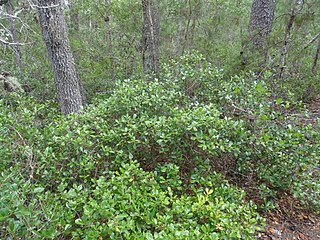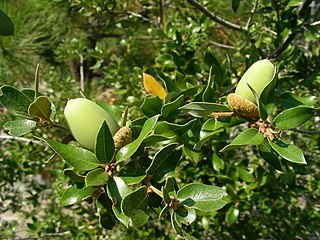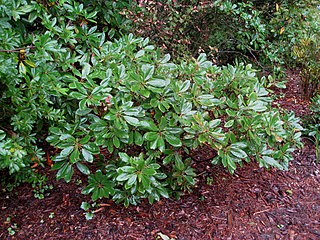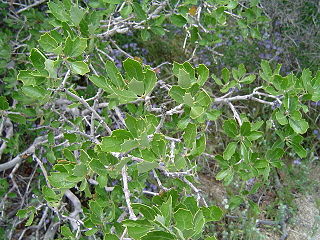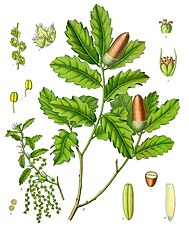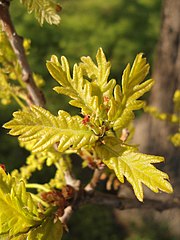Quercussubg.Quercus
| Quercussubg.Quercus | |
|---|---|
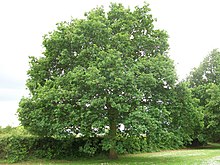
| |
| Quercus robur(type species) growing in England | |
| Scientific classification | |
| Kingdom: | Plantae |
| Clade: | Tracheophytes |
| Clade: | Angiosperms |
| Clade: | Eudicots |
| Clade: | Rosids |
| Order: | Fagales |
| Family: | Fagaceae |
| Genus: | Quercus |
| Subgenus: | Quercussubg.Quercus |
| Sections[2] | |
| |
QuercussubgenusQuercusis one of the twosubgenerainto which the genusQuercuswas divided in a 2017 classification (the other beingsubgenusCerris). It contains about 190 species divided among fivesections.It may be called the New World clade or the high-latitude clade; most species are native to the Americas, the others being found inEurasiaand northernmostNorth Africa.
Description[edit]
Members of subgenusQuercusare distinguished from members of subgenusCerrisby few morphological features, their separation being largely determined bymolecular phylogeneticevidence. All are trees or shrubs bearingacorn-like fruit in which a cup covers at least the base of the nut. The outer structure of the maturepollenis one feature that distinguishes the two subgenera: in subgenusQuercus,the small folds or wrinkles (rugulae) are obscured bysporopollenin,whereas in subgenusCerris,the rugulae are visible or at most weakly obscured.[2]
The two subgenera are also distinguished to some extent by their different distributions. SubgenusQuercusoccurs mainly in the Americas, with some species native toEurasiaandNorth Africa,and may be called the New World clade or the high-latitude clade. SubgenusCerrisis primarily Eurasian, with a few species in North Africa, and may be called the Old World clade or the mid-latitude clade.[2]
Taxonomy[edit]
Phylogeny[edit]
The followingcladogramsummarizes the relationships that Denk et al. used to draw up their 2017 classification:[2]
| Quercus |
| |||||||||||||||||||||||||||||||||
SectionLobatae[edit]
Quercussect.Lobataewas established byJohn Claudius Loudonin 1830.[3]The section, or part of it, has also been treated under names includingQuercussect.RubraeLoudonandQuercussect.ErythrobalanusSpach.It has also been treated as the subgenusErythrobalanusand as the full genusErythrobalanus(Spach) O.Schwarz.Its members may be called red oaks.[2]
Theperianthof thepistillateflowers has a characteristic flange-like shape. Thestaminateflowers have up to sixstamens.The stalk connecting the perianth to theovaryis cone-shaped and often has rings. The acorns mature in two years, rarely in one year. The 'cup' (cupule) of the acorn is fused with its stalk (peduncule) forming a connective piece. Both the connective piece and the cup are covered with small triangular scales, mostly thin and membranous with broadly angled tips. The leaves typically have teeth with bristle-like extensions, or just bristles in leaves without teeth.[2]
The section contains about 125 species native toNorthern America(includingMexico),Central America,andColombiain South America.[2]The red oaks of Mexico are one of the groups of oaks that have most rapidly diversified into different species. Molecular evidence suggests that there are significant numbers of undescribedQuercusspecies in Mexico, so the number of known species in the section is likely to be an underestimate of the total diversity.[4]
-
Quercus castanealeaves and acorns
-
Leaves ofQuercus ellipsoidalis
-
Quercus myrtifoliagrowing as a shrub
-
Quercus rubrain autumn (in cultivation)
SectionProtobalanus[edit]
Quercussect.Protobalanuswas first established as a subgenus byWilliam Treleasein 1922 and then later treated as a section byOtto Karl Anton Schwarzin 1936 andAimée Antoinette Camusin 1938.[2][note 1]
Thestaminateflowers have eight to tenstamens.Thepollenornamentation has only small wrinkles or folds (verrucae). The acorns mature after two years. The cup (cupule) at the base of the acorn has triangular scales that are fused at the base and have sharp angled tips. The scales are thick and compressed into rings, often forming small bumps, that may be obscured by glandular hairs. The leaf teeth end in spines.[2]
The section contains only five species, native to southwestern North America and northwestern Mexico.[2]
-
Quercus cedrosensisin habitat in Mexico
-
Quercus chrysolepisleaves showing spines
-
Quercus chrysolepisacorns
-
Quercus tomentellain habitat onSanta Rosa Island,California
-
Quercus tomentellaacorn
SectionPonticae[edit]
Quercussect.Ponticaewas first established byBoris Stefanoffin 1930. It has also been treated as a subsection and a series, including under the nameQ.ser.SadlerianaeTrelease.[2]
Species are shrubs or small trees, withrhizomes.Thestaminatecatkinsare up to 10 cm long. The cup (cupule) at the base of the acorn has scales with sharp angled ends. The leaves are either evergreen or deciduous, with simple or compound teeth. The leaf buds are large, enclosed in loosely attached scales.[2]
There are only two species,Quercus ponticaandQuercus sadleriana.[5]They have disjoint distributions.Quercus ponticais native to mountainous areas of north-easternTurkeyand westernGeorgia.Quercus sadlerianais native to northern-mostCaliforniaand southern-mostOregonin the United States.[2]
-
Quercus ponticain habitat
-
Quercus sadlerianain cultivation
SectionVirentes[edit]
Quercussect.Virenteswas first established byJohn Claudius Loudonin 1838. It has also been treated as a series.[2]Members of the section may be called live oaks.[6]
Species are trees orrhizomatousshrubs. They areevergreenorbrevideciduous.The acorns mature in a year. The cup at the base of the acorn has narrowly triangular scales, with thin keels, at most small bumps (tubercules), and sharp angled ends. The leaves are evergreen or almost so. A distinctive feature of the section is that the germinating seed has fused seed leaves (cotyledons) and an elongated stem above the cotyledons (theepicotyl) that forms a tube, while the stem below the cotyledons (thehypocotyl) istuberous.[2]
The section contains seven species, native to south-eastern Northern America, Mexico, the West Indies (Cuba), and Central America.[2]
SectionQuercus[edit]
Quercussect.Quercushas been known, either in whole or part, by a variety of names in the past, includingQuercussect.Albae,Quercussect.MacrocarpaeandQuercussect.Mesobalanus.Members of the section may be called white oaks. The section includes all white oaks from North America (treated by Trelease as subgenusLeucobalanus).[2]
Thestaminateflowers have seven or morestamens.Theacornsmature in one year. The seed leaves (cotyledons) are either free or fused together. The cup at the base of the acorn has thickened triangular scales that are either free or fused at the base and have sharp angled tips. The scales have keels and are often covered with small bumps (tuberculate). The leaf teeth typically do not have either bristle-like or spiny tips.[2]
There are about 150 species, native to Northern America, Mexico, Central America, westernEurasia,East Asia, and North Africa.[2]
-
LargeQuercus albagrowing inNew Jersey
-
Quercus albacatkins (staminate or 'male' flowers)
-
Quercus berberidifoliain habitat inCalifornia
-
Illustration ofQuercus lusitanicashowing staminate (left) and pistillate flowers (top right)
-
Quercus petraeain England, about 300 years old
-
New leaves and pistillate ('female') flowers ofQuercus robur
-
Quercus roburleaves and acorns
Notes[edit]
References[edit]
- ^abSchwarz, O. (1936), "Entwurf zu einem natürlichen System der Cupuliferen und der GattungQuercusL. ",Notizblatt des Königlichen Botanischen Gartens und Museums zu Berlin(in German),13(116): 1–22,doi:10.2307/3994908,JSTOR3994908,p. 21
- ^abcdefghijklmnopqrsDenk, Thomas; Grimm, Guido W.; Manos, Paul S.; Deng, Min & Hipp, Andrew L. (2017),"An Updated Infrageneric Classification of the Oaks: Review of Previous Taxonomic Schemes and Synthesis of Evolutionary Patterns",in Gil-Pelegrín, Eustaquio; Peguero-Pina, José Javier & Sancho-Knapik, Domingo (eds.),Oaks Physiological Ecology. Exploring the Functional Diversity of GenusQuercusL.,Cham.: Springer International Publishing, pp. 13–38,doi:10.1007/978-3-319-69099-5_2,ISBN978-3-319-69099-5
- ^"Quercussect.LobataeLoudon ",The International Plant Names Index,retrieved2023-02-25
- ^Hipp, Andrew L.; Manos, Paul S.; Hahn, Marlene; Avishai, Michael; Bodénès, Cathérine; Cavender-Bares, Jeannine; Crowl, Andrew A.; Deng, Min; Denk, Thomas; Fitz-Gibbon, Sorel; Gailing, Oliver; González-Elizondo, M. Socorro; González-Rodríguez, Antonio; Grimm, Guido W.; Jiang, Xiao-Long; Kremer, Antoine; Lesur, Isabelle; McVay, John D.; Plomion, Christophe; Rodríguez-Correa, Hernando; Schulze, Ernst-Detlef; Simeone, Marco C.; Sork, Victoria L. & Valencia-Avalos, Susana (2020),"Genomic landscape of the global oak phylogeny"(PDF),New Phytologist,226(4): 1198–1212,doi:10.1111/nph.16162,PMID31609470
- ^Denk, Thomas; Grimm, Guido W.; Manos, Paul S.; Deng, Min & Hipp, Andrew L. (2017-11-02),"Appendix 2.1: An updated infrageneric classification of the oaks"(xls),figshare,doi:10.6084/m9.figshare.5547622.v1,retrieved2023-02-17
- ^Cavender‐Bares, Jeannine;González‐Rodríguez, Antonio; Eaton, Deren A. R.; Hipp, Andrew A. L.; Beulke, Anne; Manos, Paul S. (2015), "Phylogeny and biogeography of the American live oaks (QuercussubsectionVirentes): a genomic and population genetics approach ",Molecular Ecology,vol. 24, no. 14, pp. 3668–3687,doi:10.1111/mec.13269,PMID26095958
- ^"Schwartz, Oskar (1901-1945)",The International Plant Names Index,retrieved2023-02-25
- ^"Les Chênes: Monographie du genreQuercus",The International Plant Names Index,retrieved2023-02-25




